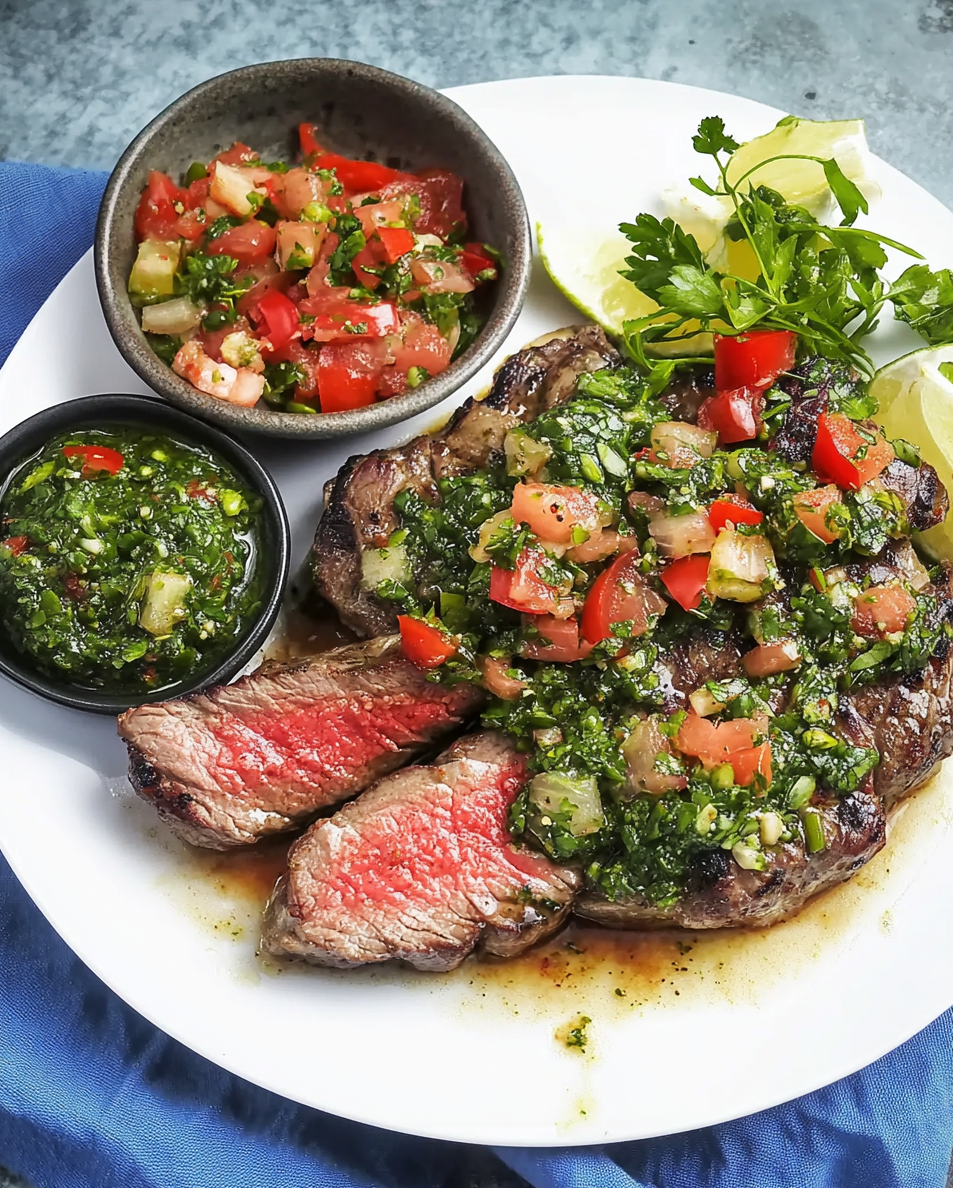The combination of juicy, marinated steaks and the zesty red chimichurri sauce makes this dish a standout at any BBQ or dinner gathering. The robust flavors of garlic, fresh parsley, and red chile flakes elevate the steak, giving it a vibrant, bold taste that’s characteristic of Argentinian cuisine.
This recipe is ideal for those who love grilling and want to impress their guests with something both simple and deeply flavorful. Whether you’re grilling for a summer BBQ or a cozy family meal, the Argentinian Steak with Red Chimichurri is sure to be a hit.
Full Recipe:
- 1/2 cup fresh parsley
- 1/4 cup onion, finely chopped
- 1/2 cup tomato, finely chopped
- 1/2 cup red bell pepper, finely chopped
- 3 garlic cloves, minced
- 1 tsp dried oregano
- 1 tsp paprika
- 1 tsp salt
- 1 bay leaf
- 1/2 tsp black pepper
- 1/2 tsp red chile flakes
- 1/2 cup red wine vinegar
- 1/2 cup water
- 1/2 cup olive oil
- 2 lbs steaks (sirloin, ribeye, or your choice)
- 1/4 cup sweet onions, finely chopped
- 2 tbsp fresh cilantro, chopped
- 1/4 cup white wine vinegar
- 1 tbsp olive oil
- 1 tsp fresh thyme, chopped
- 1 tsp cumin
Directions:
- Combine parsley, onion, tomato, bell pepper, garlic, oregano, paprika, salt, bay leaf, black pepper, and chile flakes in a large bowl. Let the mixture sit for 30 minutes.
- Add red wine vinegar and water to the chimichurri, let it sit for another 30 minutes.
- Mix olive oil into the chimichurri and transfer to a non-reactive container. Refrigerate for 6 hours to 2 days, ensuring the liquid covers all ingredients.
- Poke steaks with a fork. Prepare the steak marinade by combining sweet onions, cilantro, white wine vinegar, olive oil, garlic, thyme, oregano, and cumin.
- Place steaks in the marinade and refrigerate for at least 6 hours or overnight.
- Preheat the grill to high heat and lightly oil the grates.
- Sear the steaks for 2 minutes on each side. Lower the heat to medium and grill for an additional 5 minutes on each side, or until desired doneness.
- Serve the steaks with the red chimichurri sauce.
Prep Time: 15 minutes | Cooking Time: 10 minutes | Total Time: 25 minutes
Kcal: 400 kcal per serving | Servings: 4
Background and Origins
Argentinian cuisine is renowned for its focus on high-quality meats, particularly beef, and the art of grilling (known as asado). This recipe for Argentinian Steak with Red Chimichurri is a perfect reflection of the country’s grilling culture. Chimichurri, a traditional Argentinian condiment, is typically made with green herbs, but this version introduces a bold twist with its red hue, featuring tomatoes and red bell peppers for a richer, deeper flavor. The chimichurri sauce pairs beautifully with grilled meats, offering a zesty, slightly spicy contrast to the savory, juicy steak.
The use of chimichurri in Argentine cooking dates back centuries and remains a staple of Argentine BBQ culture. It’s not only a sauce but also a marinade and condiment used to enhance the flavor of various cuts of beef, pork, and chicken. This version of the dish uses both parsley and cilantro, giving the chimichurri a fresh, herbaceous taste that complements the richness of the steak.
Why this Recipe Works
The beauty of this recipe lies in its simplicity. By allowing the steak to marinate in a mixture of onions, garlic, vinegar, and spices, it absorbs rich flavors that penetrate deep into the meat. The grilling process, where the steak is first seared at high heat and then cooked at a lower temperature, ensures a perfectly charred exterior with a tender, juicy inside. The red chimichurri, with its mixture of tangy vinegar, fresh herbs, and spices, adds brightness and complexity to the dish.
- Customizable: The recipe is highly adaptable. You can experiment with different cuts of beef, such as ribeye, sirloin, or flank steak. Additionally, if you prefer a milder chimichurri, simply reduce the amount of chile flakes or omit them altogether.
- Meal Prep Friendly: Both the steak and chimichurri can be prepared in advance. The chimichurri actually improves in flavor the longer it sits, making it an excellent sauce to keep in the fridge for up to two days.
- Perfect for Grilling: Asados (Argentinian BBQs) are social events, and this dish is perfect for entertaining. The grilling method ensures a smoky, rich flavor that is hard to achieve with other cooking methods.
Tips for Making the Perfect Argentinian Steak with Red Chimichurri
- Rest the Meat: After grilling, allow the steak to rest for 5–10 minutes before slicing. This helps the juices redistribute throughout the meat, resulting in a more flavorful, tender bite.
- Use Fresh Ingredients: Chimichurri relies heavily on fresh herbs, garlic, and a balance of acid (vinegar) and oil. Fresh parsley, cilantro, and quality olive oil make a noticeable difference in the flavor of the sauce.
- Adjust for Spice: If you prefer a less spicy chimichurri, cut back on the red chile flakes or replace them with a milder pepper. For a spicier version, increase the amount or add fresh red chilies.
Serving Suggestions
This steak is best served with a side of grilled vegetables, roasted potatoes, or even a fresh green salad to balance the richness of the meat. You can also serve it with provoleta (grilled provolone cheese) and crusty bread, which are common accompaniments in Argentine asados. Another option is to slice the steak thinly and serve it in tacos or wraps for a more casual meal.
Wine Pairing
Argentinian steak pairs beautifully with a robust red wine. A Malbec is the most popular choice, as its bold, fruity flavors and moderate tannins complement the rich, savory flavors of the grilled steak and tangy chimichurri. Alternatively, a Cabernet Sauvignon or Syrah would work equally well, providing depth and structure to the meal.
Dietary Considerations
This dish is naturally gluten-free and can be easily adapted for various dietary preferences. For a low-carb or keto-friendly version, serve the steak with grilled vegetables or a fresh salad. If you are avoiding dairy, this dish is already dairy-free, making it a great option for those with lactose intolerance.
The Tradition of Asado: A Social and Culinary Experience
In Argentina, the asado (barbecue) is much more than just a method of cooking; it’s a cherished social event that brings family and friends together. The process of grilling meat over an open flame, typically wood or charcoal, is a centuries-old tradition that plays a central role in Argentine culture.
Asado is often a long, leisurely event where various cuts of meat, including sausages, ribs, and steaks, are cooked slowly and enjoyed over several hours. The parrillero, or grill master, takes pride in their ability to perfectly sear and cook the meat, ensuring that each cut retains its juiciness and flavor. Chimichurri is the classic condiment of choice at an asado, served with almost every grilled meat.
Incorporating this recipe into an asado menu is a wonderful way to share a taste of Argentina’s rich culinary heritage with your guests. Pair it with other traditional sides like ensalada criolla (a fresh tomato and onion salad) or empanadas for a full Argentine dining experience.
The Versatility of Chimichurri
Chimichurri is not just for steak. This vibrant, herbaceous sauce is incredibly versatile and can be used in a variety of dishes. Here are a few creative ways to use leftover chimichurri:
- Marinade for Chicken or Fish: Use chimichurri as a marinade for chicken thighs or fish fillets before grilling or roasting. The acidity from the vinegar tenderizes the protein, while the herbs add a fresh, zesty flavor.
- Dip for Vegetables: Chimichurri makes an excellent dip for roasted or grilled vegetables, adding a burst of flavor to otherwise simple side dishes.
- Salad Dressing: Mix a few tablespoons of chimichurri with extra olive oil and a splash of lemon juice to create a tangy, herb-filled dressing for salads or grain bowls.
- Sandwich Spread: Use chimichurri as a spread on sandwiches or wraps to give them a bold, flavorful kick.
The recipe you’re sharing, featuring red chimichurri, is an exciting variation. The addition of bell peppers and tomatoes gives the sauce a slightly sweeter and richer flavor profile compared to the traditional green chimichurri.
Health Benefits of Chimichurri and Steak
This dish isn’t just delicious; it also offers some great nutritional benefits:
- Rich in Protein: The steak provides a substantial amount of high-quality protein, which is essential for muscle repair, immune function, and overall health. Protein also helps you feel full and satisfied after a meal.
- Packed with Vitamins and Antioxidants: Chimichurri is made with fresh herbs like parsley and cilantro, which are packed with vitamins (especially vitamin K and C), antioxidants, and phytonutrients. These can help reduce inflammation, support immune function, and protect against certain diseases.
- Healthy Fats: Olive oil, a key ingredient in chimichurri, is a source of monounsaturated fats, which are known to support heart health. The garlic in chimichurri also has compounds that may help support cardiovascular health and boost the immune system.
Cooking Tips for the Perfect Steak
Here are some pro tips to ensure your steak is grilled to perfection:
- Choose the Right Cut: For this recipe, you can use various cuts of steak. Ribeye, sirloin, and strip steak are excellent choices because they have a good balance of marbling and tenderness. If you’re looking for a leaner option, flank steak or skirt steak are also great, but be sure to cook them to medium-rare to avoid toughness.
- Preheat the Grill: Make sure your grill is hot before adding the steak. Starting with a high heat sear helps to lock in the juices and create that beautiful char on the outside.
- Use a Meat Thermometer: To achieve the perfect level of doneness, use a meat thermometer. For medium-rare, aim for an internal temperature of 130-135°F (54-57°C); for medium, aim for 140-145°F (60-63°C). Remember that the steak will continue to cook slightly after being removed from the grill.
- Let the Meat Rest: After grilling, let the steak rest for 5-10 minutes before slicing. This allows the juices to redistribute throughout the meat, resulting in a more flavorful and juicy steak.
Chimichurri Variations Around South America
While chimichurri is most closely associated with Argentina, there are regional variations of this sauce found throughout South America:
- Uruguayan Chimichurri: In Uruguay, chimichurri is often made with a coarser texture and includes red bell pepper for extra sweetness. It may also be slightly thicker than the Argentine version, making it perfect for slathering on grilled meats.
- Brazilian Molho à Campanha: Similar to chimichurri, this Brazilian sauce is made with chopped tomatoes, onions, parsley, and bell peppers, but it’s less herb-forward and more of a salsa than a sauce.
- Chilean Pebre: Pebre is Chile’s take on chimichurri. Made with cilantro, onions, tomatoes, and chili peppers, it’s spicier and chunkier. It’s commonly served as an accompaniment to grilled meats or seafood.
Hosting an Authentic Argentinian Asado
If you want to go beyond just serving the steak and chimichurri, consider hosting a full asado experience at home:
- Set the Scene: Use wooden or rustic-themed table settings to evoke the feel of a traditional Argentine barbecue. Serve the meal family-style, where everyone can help themselves.
- Start with Appetizers: Traditional asado appetizers include provoleta (grilled provolone cheese), choripán (grilled sausage sandwiches), and empanadas filled with beef or vegetables.
- Serve Classic Sides: In addition to the chimichurri, classic asado sides include grilled vegetables, papas a la parrilla (grilled potatoes), ensalada mixta (mixed salad), and chimichurri potatoes.
- End with a Sweet Treat: Finish the meal with an Argentinian dessert like dulce de leche served with crepes, or alfajores (shortbread cookies filled with dulce de leche and rolled in coconut).
Conclusion
The Argentinian Steak with Red Chimichurri is a flavorful, vibrant dish that perfectly captures the essence of Argentina’s grilling culture. The combination of juicy, marinated steak and zesty chimichurri sauce offers bold, fresh flavors ideal for a BBQ or family meal. With its rich tradition, versatility, and ease of preparation, this recipe is a fantastic way to bring the authentic taste of an Argentinian asado to your table. Whether you’re hosting a gathering or cooking a weeknight dinner, this dish is sure to impress.






